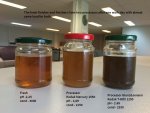Hello,
is there any method to determine the condition of finishing gum before the printing ? The main interest is how well plates are desensitized. We use Kodak Finisher 850S (acidic) and process plates in advance for 1-2 days, 260-300 square meters per day. It is very not comforting to hear suddenly in a morning from pressroom about huge of paper waste in the night shift.
What signs or measurements would show about bad the current finisher gum condition ?
Thanks in advance,
Saulius
is there any method to determine the condition of finishing gum before the printing ? The main interest is how well plates are desensitized. We use Kodak Finisher 850S (acidic) and process plates in advance for 1-2 days, 260-300 square meters per day. It is very not comforting to hear suddenly in a morning from pressroom about huge of paper waste in the night shift.
What signs or measurements would show about bad the current finisher gum condition ?
Thanks in advance,
Saulius












